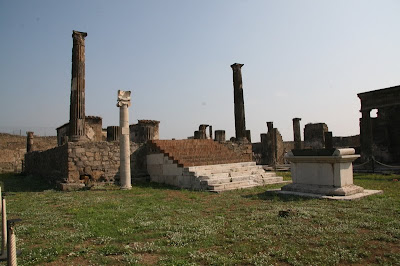Published: July 15, 2010

(An adoption project helps find homes for stray dogs like Sallustius in Pompeii, Italy.)
POMPEII, Italy — One of Pompeii’s most famous mosaics is of a leashed dog with the warning “cave canem,” or beware of the dog.
That message had become all too appropriate in recent years, as visitors to the city buried by Mount Vesuvius in A.D. 79 could attest. Droopy dogs wandering forlornly along ancient streets were a common sight here. Fights could erupt at a moment’s notice, over females in heat or territory, but mostly over food. There were isolated cases of dogs attacking people. More commonly, people were scared, because the dogs tended to travel in packs, tracking tour groups in the hope of scoring tasty treats.
When the Italian government declared a state of emergency for Pompeii in 2008, Culture Minister Sandro Bondi cited the strays as among the principal problems, along with illegal tour guides, inadequate washroom facilities and general neglect of the site.
But all that began to change last November, when administrators at the ruins introduced a project to promote the adoption of stray dogs from Pompeii.
On its Web site, the project is rendered as (C)Ave Canem. Giacomo Bottinelli, the coordinator of the project, acknowledged that the Latin was not correct. “It should be Ave Canis” — for Hail Dog — “but we didn’t want to get into anything too complicated,” said Mr. Bottinelli, who studied classical philology in college.
During the past six months, 22 dogs that had been living in the ruins have been adopted. Several more are waiting for a home.
Sallustius “is so sweet,” Mr. Bottinelli said of the 1-year-old red mongrel that never strayed far from his side. “But no one’s wanted him yet.”
Before the project started, Sallustius risked the same lonely fate as the other 70,000 dogs that the Italian Antivivisection League estimates roam the streets of the surrounding Campania region. Beyond those dogs, about 9,000 are housed in local pounds, according to 2009 Health Ministry Statistics.
“The problem of stray dogs is common in all of southern Italy,” said Mr. Bottinelli, who is also the Antivivisection League’s national director for adoptions. “Unfortunately, much of the population does not know about microchips, and they aren’t used to neutering their pets.”
Though official numbers are hazy, the Antivivisection League believes that some 135,000 animals are abandoned in Italy each year, usually during the summer, adding to the country’s stray population of more than 3 million, most of them cats.
But Pompeii has its own particularities.
More than two million tourists — potential food dispensers to dogs — visit the site each year. And every May and October, thousands of pilgrims come on foot to Pompeii to pray at the Sanctuary of the Blessed Virgin of the Rosary, which is just five minutes from the ruins. For reasons that remain obscure, many dogs are left behind when the pilgrims depart, Mr. Bottinelli said.
Illegal dog fights organized by the Camorra, the main organized crime gang here, are also common, creating an added risk for abandoned dogs. All these factors make for “critical problems in Pompeii,” Mr. Bottinelli said.
The dogs in his program get a complete medical checkup, including vaccines, and are neutered. They also receive a microchip implant that registers them in a national data bank. Only after all that can they be adopted.
“The aim is to control the stray population with the dogs’ well-being in mind,” said Roberto Scarcella, the veterinarian responsible for the adoption project. “It’s a cheaper alternative to putting them in a cage in the city pound.”
The ancient names given to the dogs — Vesonius, Diomedes or Mulvia, for example — are intended to reflect the dogs’ provenance, but the adoptive families are free to change them.
Last January, Petty Officer First Class Michael Zdunkawicz of the United States Navy, who works at the NATO base in Naples, adopted a black Labrador retriever from Pompeii. The dog was called Lucius, “but that sounded too much like the devil for me, and he’s everything but the devil,” said Petty Officer Zdunkawicz during a telephone interview. “So we renamed him Benedicto, after the pope.”
The adoption took about a month, he said, and volunteers from Pompeii made sure that his living quarters in Naples were suitable. (The adoption process is rigorous, with extensive vetting of the prospective families.)
Arguably, the excavation site at Pompeii has far more serious problems than strays.
Last month, the Italian government announced the end of the state of emergency, but much remains to be done. Many houses are still closed to the public; some recent restorations done under the aegis of the government-appointed emergency commissioner have been criticized; and concerns have been raised about transforming Pompeii into a money-making operation at the expense of protecting its archaeological wealth.
Still, the success of the dog adoption program, which costs a little more than $100,000, mostly for medical bills, suggests that small battles can be won. The project officially ends this summer, but local volunteers have been trained to take over. It is a necessity because new strays arrive all the time.
“The other side of the coin is that if you want to abandon your dog, you bring it to Pompeii because someone will take care of it,” said Pasquale Riso, a local veterinarian and a volunteer at the site. “So some people may try to take advantage of the situation.”
A version of this article appeared in print on July 16, 2010, on page A11 of the New York edition.





